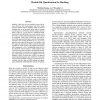Free Online Productivity Tools
i2Speak
i2Symbol
i2OCR
iTex2Img
iWeb2Print
iWeb2Shot
i2Type
iPdf2Split
iPdf2Merge
i2Bopomofo
i2Arabic
i2Style
i2Image
i2PDF
iLatex2Rtf
Sci2ools
AAAI
2012
2012
Double-Bit Quantization for Hashing
Hashing, which tries to learn similarity-preserving binary codes for data representation, has been widely used for efficient nearest neighbor search in massive databases due to its fast query speed and low storage cost. Because it is NP hard to directly compute the best binary codes for a given data set, mainstream hashing methods typically adopt a two-stage strategy. In the first stage, several projected dimensions of real values are generated. Then in the second stage, the real values will be quantized into binary codes by thresholding. Currently, most existing methods use one single bit to quantize each projected dimension. One problem with this single-bit quantization (SBQ) is that the threshold typically lies in the region of the highest point density and consequently a lot of neighboring points close to the threshold will be hashed to totally different bits, which is unexpected according to the principle of hashing. In this paper, we propose a novel quantization strategy, call...
| Added | 29 Sep 2012 |
| Updated | 29 Sep 2012 |
| Type | Journal |
| Year | 2012 |
| Where | AAAI |
| Authors | Weihao Kong, Wu-Jun Li |
Comments (0)

